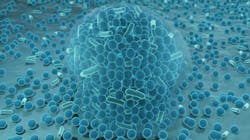It’s all about that biofilm
Most bacteria in the body do not exist as single floating cells. They live in communities called biofilms. To form a biofilm, bacteria first adhere to a surface and then generate a polysaccharide matrix that also sequesters calcium, magnesium, iron, or whatever minerals are available.
Within that biofilm, one or more types of bacteria share nutrients and DNA that then evade the immune system. The biofilm requires less oxygen, fewer nutrients, and alters the pH at the core. The biofilm forms a physical barrier that keeps more immune cells from detecting pathogenic bacteria.
Dental plaque has been identified as a biofilm.1 The nature of biofilm enhances the component of bacteria’s resistance to both the host’s defense system and antimicrobials. If it is not removed regularly, the biofilm undergoes maturation, and the resulting pathogenic bacteria complex leads to caries, gingivitis, and periodontitis.
Related articles
Understanding dental biofilm and guided biofilm therapy
Biofilm disruption: Water flossing reimagined
Guided biofilm therapy: A new dental hygiene protocol
Biofilm can’t be eliminated, but it can be reduced and controlled. Teeth comprise only 20% of mouths, so controlling biofilm is more than just brushing, flossing, interproximal brushes, and irrigators. Biofilms are unfortunately also found in dental unit waterlines, on prosthetic appliances, the tongue, biomaterials in dental restorations, and on oral mucous membranes.
Stages of biofilm formation
There are four stages of biofilm development: initial adherence, lag phase, rapid growth, and steady state.2 The adherence of bacteria to the tooth surface, also known as acquired pellicle, makes the surface receptive to colonization by specific bacteria. Usually gram-positive cocci are the first microorganisms to colonize on the teeth.
As bacteria shift from planktonic to sessile life, a genetic up-regulation or gene signaling actually promotes the shift. That genetic expression then shifts, causing a lag in bacterial growth, but that shift makes it up to 1,000 times more resistant to antibodies, antibiotics, and antimicrobial compounds than in its single cell state.
In the rapid growth stage, the adherent bacteria secrete large amounts of water-insoluble extracellular polysaccharides to form the biofilm matrix. Additional varieties of bacteria adhere to the early colonizers, known as coaggregation, and the biofilm increases and becomes more complex. This cell division also increases the thickness of the biofilm.
In the final stage, or steady state phase, the interior of the biofilm slows bacterial growth and they become immobile. This is when the biofilm may detach or slough and can travel to form new colonies.
The bacteria in the biofilm
There are hundreds of species of microorganisms in periodontal pockets, but fewer than 20 are routinely found in increased proportions. Specific virulent bacterial species activate the host’s immune and inflammatory responses, which then causes bone and soft tissue destruction.
In 1968 Dr. Sigmund Socransky classified the bacterial species involved in the initiation and progression of periodontal disease.3,4 He classified several complexes of bacteria, dividing them into groups and labeling them in colors. The categories were based upon the pathogenicity of the bacteria and their role in the development of plaque or biofilm.
His color designations of blue, yellow, green, and purple are the early colonizers of the subgingival flora. The purple and green complexes present in periodontal pockets are not significantly associated with signs of periodontal disease progression. Orange and red complexes are late colonizers associated with mature subgingival plaque. Orange complex bacteria include: Fusobacterium nucleatum, Prevotella intermedia, Prevotella nigrescens, Peptostreptococcus micros, Streptococcus constellatus, Eubacterium nodatum, Campylobacter showae, Campylobacter gracilis, and Campylobacter rectus. The species in this group are closely associated with one another and to species in the red complex.
The bacteria in the red complex are more likely to be associated with clinical indicators of periodontal disease such as periodontal pocketing and clinical attachment loss. Red complex species are strongly associated with bleeding on probing. The bacteria Porphyromonas gingivalis, Tannerella forsythia, and Treponema denticola have a strong relationship with pocket depths. P. gingivalis alone or in combination exhibits the deepest mean pocket depths. Since Dr. Socransky’s original research, another pathogen has been added to the list of high risk: Aggregatibacter actinomycetemcomitans.
Dental biofilm is a collection of living cells that—if left alone—can cause gingivitis, decay, and periodontal disease. Biofilm alone is not enough to cause systemic diseases—those are multifactorial—but it elevates risk. Biofilm can’t be eliminated but can be controlled by diligent oral hygiene practices taught to patients by clinicians, and practitioners can help manage biofilm more effectively with new technologies such as an air polishing system that uses either glycine or erythritol, which allows providers to treat patients comfortably, safely, and efficiently with a minimally invasive approach.
Editor's note: This article appeared in the July 2022 print edition of RDH magazine. Dental hygienists in North America are eligible for a complimentary print subscription. Sign up here.
References
- Marsh PD. Dental plaque as a biofilm and a microbial community - implications for health and disease. BMC Oral Health. 2006;6(Suppl 1):S14. https://bmcoralhealth.biomedcentral.com/articles/10.1186/1472-6831-6-S1-S14
- Gurenlian JR. The role of dental plaque biofilm in oral health. J Dent Hyg. 2007;81(5). https://jdh.adha.org/content/jdenthyg/81/suppl_1/116.full.pdf
- Socransky SS, Haffajee AD, Cugini MA, Smith C, Kent RL Jr. Microbial complexes in subgingival plaque. J Clin Periodontol. 1998;25(2):134-144. doi:10.1111/j.1600-051x.1998.tb02419.x
- Socransky SS, Haffajee AD. Periodontal microbial ecology. Periodontol 2000. 2005;38:135-187. doi:10.1111/j.1600-0757.2005.00107.x
About the Author

Anne O. Rice, BS, RDH, CDP, FAAOSH
Anne O. Rice, BS, RDH, CDP, FAAOSH, founded Oral Systemic Seminars after over 35 years of clinical practice and is passionate about educating the community on modifiable risk factors for dementia and their relationship to dentistry. She is a certified dementia practitioner, a longevity specialist, a fellow with AAOSH, and has consulted for Weill Cornell Alzheimer’s Prevention Clinic, FAU, and Atria Institute. Reach out to Anne at anneorice.com.
